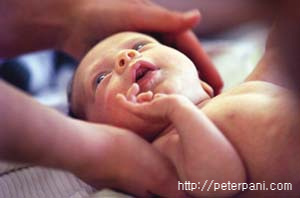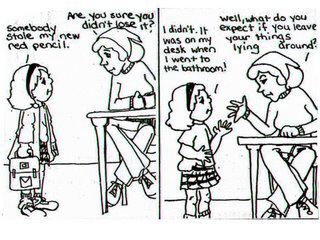Peek-a-boo is a favorite game for toddlers, and if a partner is willing, these youngsters can often continue the game for quite some time until some other distraction comes along. What is it about peek-a-boo that is so attractive at this age? The answer lies in the multi-functions this game serves in assisting young children in negotiating several major developmental tasks that are of primary importance during the first three years of life. These tasks are (1) "separation-individuation," and (2) the achievement of what's called "object constancy." Let's take these one at a time and look at how the "peek-a-boo" game provides a simple play mechanism that aids our young toddler in the journey to become a separate, autonomous little person that is emotionally secure and ready to take on the next major steps in exploring the world.
Separation-Individuation
Separation-individuation is a developmental term that refers to the process by which an infant begins to differentiate himself from his mother (or the primary caretaker). This is both a bodily and psychological process that requires many new skills such as the ability to compare himself to others, to conceptualize, to perceive differences and likenesses, to remember, to display a variety of new emotions, and so forth. This acquisition of new skills, which allows the young child to begin to widen his perception of the way things actually are (perceive reality), ultimately leads him to the accomplishment of individuation - the emergence of a separate little "self" that can relate to the world and others from the young throne of autonomy. This process goes on over a period of about three to four years, and is one of the more wondrous phases of development for parents to witness and facilitate. Like the child's emergence from his mother's womb during the process of birth, separation-individuation is the "psychological birth of the human infant" (Mahler, 1975) during the early years of life. There are several steps, or subphases, in the process of separation-individuation that occur fairly chronologically, with some overlap as the child practices what he has learned. Generally, these steps are referred to as the differentiation phase, practicing phase, and rapprochement.
Differentiation Phase
This phase begins somewhere around four to five months of age. Up until that point, the young infant has enjoyed a very symbiotic relationship with her mother, which simply means that she has experienced her mother for the most part as simply an extension of herself. It's sort of an extended womb-like experience where all the needs of the infant are magically fulfilled when needed. Mother and child are not really different at this point for the infant. Fairly soon, however, the baby begins to discern mommy's face along with the sense of love and warmth that comes from her. We begin to see the infant smile at mommy in a way that shows some recognition and attachment, and signifies a special bond. Baby can now differentiate between her mommy and others in the environment. It takes her a little longer, however, to begin to differentiate between herself and mommy. We begin to see the initiation of the process of physical differentiation that is facilitated by baby's alternately molding her body toward her mommy's, and then distancing her body by arching away. Through movement while being held by mommy, the baby is allowed to get the first inklings of having some separation from mommy, however, this is still very tentative. Touch is the primary sensory activity that allows for this beginning differentiation process.
Around six months of age, the process of separation-individuation gets into full swing as differentiation takes on a more exploratory quality. Very simply, baby becomes fascinated with mommy's face as exemplified by pulling on her nose and ears, putting her hands into mommy's mouth, rearing away from her in order to get a better look at her, grabbing her hair, etc. Around this time, the game of peek-a-boo may emerge for the first time as mommy alternately hides her face and reappears for baby. Although baby is fascinated, peek-a-boo is experienced very passively by baby in that mommy does all of the work, and baby watches, not yet entering into the game except as observer.
Practicing Phase
The process of differentiation continues in this next phase, which is characterized by baby's newfound abilities to physically put distance between herself and mommy. At seven to eight months, most babies begin pulling up on furniture, sitting upright, crawling, and scooting across the floor. All of these new motor skills allow baby to actually move away from mommy, which adds the new dimension of physical separation to the process of differentiation. Not only is mommy's face different than other's, but baby is different than mommy as can now be experienced by separation from mommy, if only for small distances. This newfound separation is wondrous, but also somewhat scary to the budding toddler, particularly when she gains the capacity to stand upright and walk. Walking signifies the hallmark of physical separation, and the accompanying increased differentiation that naturally occurs. It also presents another problem for the toddler who now finds herself alternately elated at her new skills and new vision of the world (from the upright position), and anxious during periods of distance from mommy which are somewhat frightening. Remember, this little person has come a long way, but emotionally she is not yet a fully individuated little self that is able to maintain the security of her mommy's love when away from her. She now has to learn to enjoy mommy from a distance, and to maintain that solid bond from afar. This is done simply by "practicing". Baby moves away from mommy, turns around and looks at her, gestures to her, makes sounds at her, and then runs back to her. Mommy serves as her "home base" - the place where baby can refuel by making physical contact and reestablishing that emotional bond before going back out into the world to explore. Stanley and Nancy Greenspan call this new kind of practicing communication "distal communication" (1985), which is characterized by the toddler's maintaining the feeling of attachment over distance through the use of gestures, voice, and eye contact. The toddler is literally practicing having mommy at a distance, while also practicing and mastering her new skills of locomotion and independence. Peek-a-boo takes on a very active quality during this phase. It allows the toddler to practice losing and regaining mommy over and over, similar to the practice of moving away from and back to mommy for refueling.
Rapprochement
The phase called rapprochement (Mahler, 1975) begins around 18 months of age, and signifies the infant's full status now as a toddler. As the toddler's physical capacities increase, allowing for greater distancing and locomotion, there is also an expansion of her cognitive capacities and need for more intimate emotional experiences. Whereas she was most interested in exploring the new world with mommy serving primarily as a home base and refueling station, she now moves her interests in the direction of social interaction. Instead of being primarily interested in the world of things, she has a new interest in personal exchange. Mommy takes on a new role, which is someone with whom the toddler can share her experience, and whom she can imitate and identify with. She brings mommy toys to play with and share; she darts away from her until mommy chases her and swoops her up in her arms; she imitates mommy's facial expressions, and mommy mirrors them back to her. The toddler again plays peek-a-boo, but in a much more elaborate fashion. She uses many more gestures and sounds and may extend the game to hide and seek. She is displaying her new awareness of mommy as having a separate existence that is both similar to and different than hers. Moreover, mommy has certain functions and desires, some of which are different than the toddler's, and some of which even oppose the toddler's desires. So begins the process of learning to see mommy as the one who gives and nurtures, and also the one who obstructs and inhibits. Mommy is both "good mommy" and "bad mommy". The clash of desires, along with the toddler's growing awareness of herself as a separate person, creates a good deal of separation anxiety and frustration for the toddler. This developmental jump is the basis of the so-called "terrible twos", which most parents know actually moves into the "terrible threes", at least for the first half of the third year. This brings us to the next big leap, which is "object constancy."
Object Constancy
Object constancy refers to the toddler's ability to maintain a sense of mommy even when she is not there. This is done in both a literal, physical sense, and then later in a more psychic, emotional way. The literal approach begins, as we have seen, during the practicing phase during which time the toddler is consumed with learning how to place more and more physical distance between she and mommy, while at the same time maintaining the safety and security of the emotional bond with her. The sense of security at this stage is facilitated primarily by touch, and in increasing amounts by gesturing, rudimentary language, and eye contact. Mommy (the object), is maintained in a constant way as long as the toddler has contact with her directly. As the toddler matures, and both her capacity for conceptualization and emotional maturity increase, she gains the ability to begin to internalize mommy in a sort of psychological (or emotional) way so that when she is not physically present, the toddler can still psychologically access a sense of mommy and the soothing qualities that she embodies.
Here's the beauty of peek-a-boo: just as mommy disappears and reappears in the game of peek-a-boo, mommy now can literally disappear, but the toddler knows she still exists and will return. She can create mommy's image in her mind's eye, and with it all the memories of how mommy sounds, feels, smells, and interacts with her. She can feel the security of mommy's presence, while yet maintaining a separateness that is now her little "self." This image provides tranquility, but also a solid quality to the new personality that is now ready to take off into the world of dreams and imagination, where the world becomes an environment of expansion and possibility.
So, remember that when you play peek-a-boo with your toddler, you are not only providing some very enjoyable entertainment and interaction with her, you are actually aiding her in facilitating some of the most important developmental steps that lead to the foundation of the personality.













